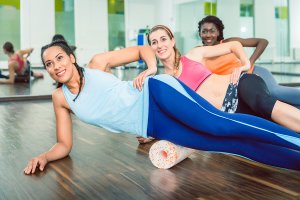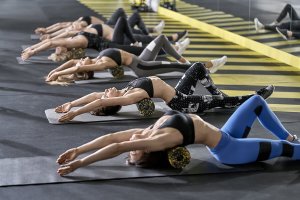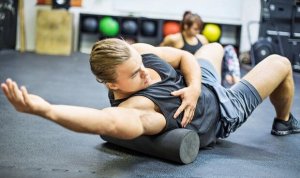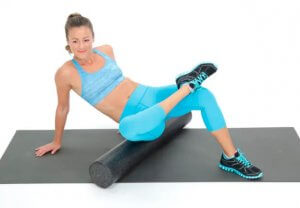How to use a Foam Roller after Exercising

In the past, this therapeutic accessory was seen by trainers and athletes as something foreign and even unnecessary. However, we now see the foam roller in many gyms and also in spas. Today, many athletes and trainers alike know that muscle pain and certain injuries can often be treated by using the foam roller.
In practice, roller treatments have been around for decades and are very common in physiotherapy. Oriental medicine therapies also include the use of rollers. In case you didn’t know, this product can be very useful during stretching routines.
What is a foam roller and how should you use it?
The foam roller is cylinder made from hard unicellular foam rubber, although of different densities. The foam roller comes in different presentations, which vary depending on its hardness. The heavier and more muscular the athlete’s body is, the harder and firmer the foam roller should be.
To use this accessory, athletes and fitness practitioners usually lie on their backs and roll over it. Ideally, you should use it on every part of your body, following a routine. Many athletes use the foam roller to stretch their obliques and gluteal muscles.
Basically, it works under the same principles as acupressure. This is an oriental discipline that encourages healing through body surface pressure.
By using the foam roller you’ll stretch your muscles deeply, releasing all tension. There are several different therapies you can follow using the foam roller, and the one you choose will depend on what the results you want to achieve are.
Myofascial Liberation and the foam roller
Actually, there’s no single way to use the foam roller. As it is, there isn’t a consensus on how often you should use the foam roller or for how long. It has almost no contraindications because it’s a therapeutic element.
The principle behind the foam roller is myofascial liberation. This principle basically explains that muscle groups are all related to each other. When one muscle group isn’t working as its best, the others tense to compensate. This kind of tension can result in muscular overloading.
When muscular overload happens, physiotherapists use massages to help the muscles to relax. With these rollers, we can release muscular tension in an easy way. The best thing about foam rollers is that we don’t need professional help to use them.
Upper body exercises using the foam roller
Almost all muscle groups can be stretched with the aid of the foam roller through easy routines. The most important thing is to maintain relaxed postures when using the instrument.
A great exercise to start using the roller is to lay over it, chest up, keeping your body straight. You should start this stretching exercise with the roller right below your shoulders. Then, you should roll over it until the roller is by your middle back, right below your waist.
Keep your back relaxed over the roller, so your weight falls and the muscles enjoy a deep massage. Also, remember to always keep the soles of your feet on the floor to provide stability and steadiness.

A variation of this exercise is the side roll. You should lay with the roller below your hips, keeping your body straight by placing your bent arm below your shoulder. Then, roll down over it until it reaches your waist. Repeat the movement several times, and then do it on the other side of your body.

We can also relax buttocks and legs
We can work the gluteal muscles if you sit on the roller, keeping your body slightly bent backward. You should hold the weight of your body with your hands placed behind you on the floor. Keep both your feet on the floor; this will help you maintain stability.

To relax your quadriceps, form the plank position, bending your arms to place your elbows and forearms on the floor. Place the foam under your thighs. Aided by your elbows and your feet, roll your thighs over the implement. You can also work your inner thighs if you modify this exercise slightly. The trick is to always roll the cylinder in the same direction as the muscle group.
If you want a deeper massage, you can work your hip flexors or even your hamstrings with this tool. There aren’t many routines to follow. You must do what feels right for your body, and design the stretching routines with a little imagination.
In short, using the foam roller is extremely simple. All you need to do is lay down over it and, with control, roll over it. If you’re a professional athlete, you can use the roller each day after training.
In the past, this therapeutic accessory was seen by trainers and athletes as something foreign and even unnecessary. However, we now see the foam roller in many gyms and also in spas. Today, many athletes and trainers alike know that muscle pain and certain injuries can often be treated by using the foam roller.
In practice, roller treatments have been around for decades and are very common in physiotherapy. Oriental medicine therapies also include the use of rollers. In case you didn’t know, this product can be very useful during stretching routines.
What is a foam roller and how should you use it?
The foam roller is cylinder made from hard unicellular foam rubber, although of different densities. The foam roller comes in different presentations, which vary depending on its hardness. The heavier and more muscular the athlete’s body is, the harder and firmer the foam roller should be.
To use this accessory, athletes and fitness practitioners usually lie on their backs and roll over it. Ideally, you should use it on every part of your body, following a routine. Many athletes use the foam roller to stretch their obliques and gluteal muscles.
Basically, it works under the same principles as acupressure. This is an oriental discipline that encourages healing through body surface pressure.
By using the foam roller you’ll stretch your muscles deeply, releasing all tension. There are several different therapies you can follow using the foam roller, and the one you choose will depend on what the results you want to achieve are.
Myofascial Liberation and the foam roller
Actually, there’s no single way to use the foam roller. As it is, there isn’t a consensus on how often you should use the foam roller or for how long. It has almost no contraindications because it’s a therapeutic element.
The principle behind the foam roller is myofascial liberation. This principle basically explains that muscle groups are all related to each other. When one muscle group isn’t working as its best, the others tense to compensate. This kind of tension can result in muscular overloading.
When muscular overload happens, physiotherapists use massages to help the muscles to relax. With these rollers, we can release muscular tension in an easy way. The best thing about foam rollers is that we don’t need professional help to use them.
Upper body exercises using the foam roller
Almost all muscle groups can be stretched with the aid of the foam roller through easy routines. The most important thing is to maintain relaxed postures when using the instrument.
A great exercise to start using the roller is to lay over it, chest up, keeping your body straight. You should start this stretching exercise with the roller right below your shoulders. Then, you should roll over it until the roller is by your middle back, right below your waist.
Keep your back relaxed over the roller, so your weight falls and the muscles enjoy a deep massage. Also, remember to always keep the soles of your feet on the floor to provide stability and steadiness.

A variation of this exercise is the side roll. You should lay with the roller below your hips, keeping your body straight by placing your bent arm below your shoulder. Then, roll down over it until it reaches your waist. Repeat the movement several times, and then do it on the other side of your body.

We can also relax buttocks and legs
We can work the gluteal muscles if you sit on the roller, keeping your body slightly bent backward. You should hold the weight of your body with your hands placed behind you on the floor. Keep both your feet on the floor; this will help you maintain stability.

To relax your quadriceps, form the plank position, bending your arms to place your elbows and forearms on the floor. Place the foam under your thighs. Aided by your elbows and your feet, roll your thighs over the implement. You can also work your inner thighs if you modify this exercise slightly. The trick is to always roll the cylinder in the same direction as the muscle group.
If you want a deeper massage, you can work your hip flexors or even your hamstrings with this tool. There aren’t many routines to follow. You must do what feels right for your body, and design the stretching routines with a little imagination.
In short, using the foam roller is extremely simple. All you need to do is lay down over it and, with control, roll over it. If you’re a professional athlete, you can use the roller each day after training.
All cited sources were thoroughly reviewed by our team to ensure their quality, reliability, currency, and validity. The bibliography of this article was considered reliable and of academic or scientific accuracy.
- Daniel Little. 2016. TOP 10 HACER Y NO HACER DE RODILLO DE ESPUMA. Fit-Nation. https://s3-eu-west-1.amazonaws.com/fit.nation.website.files/Foam+Roller/TOP+10+HACER+Y+NO+HACER+DE+RODILLO+DE+ESPUMA.pdf
- Manual de Usuario del Rodillo de Espuma & Pelotas de Masaje CybGene. http://www.cybgene.com/wp-content/uploads/2018/01/Foam_Roller_User_Manual_ES.pdf
- Karl Knopf. 2015. Ejercicios con el rodillo de espuma. Ediciones Tutor S.A. http://archivosdemedicinadeldeporte.com/articulos/upload/libros_167.pdf
This text is provided for informational purposes only and does not replace consultation with a professional. If in doubt, consult your specialist.








